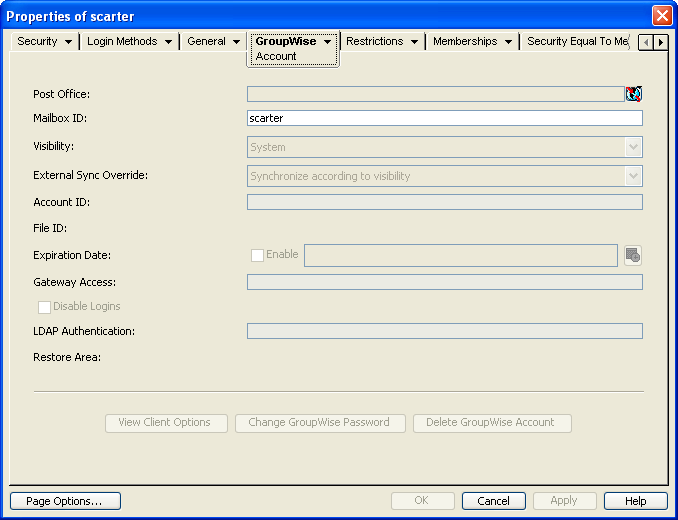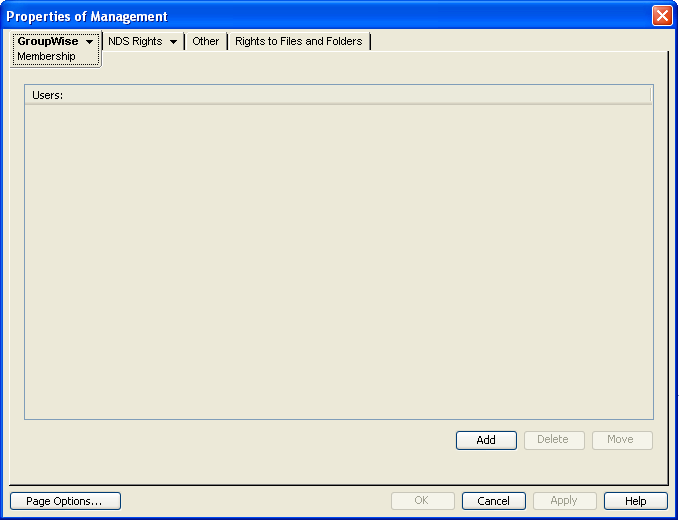13.2 Creating GroupWise Accounts for eDirectory Users
Depending on your needs, you can choose from the following methods to create GroupWise accounts for eDirectory users:
-
Creating a Single GroupWise Account: You can create a GroupWise account for a single eDirectory user by editing the GroupWise information on his or her User object. This method lets you create the GroupWise account on any post office, select the GroupWise user ID, and configure optional GroupWise information. It provides the most flexibility in creating a user’s GroupWise account.
-
Creating Multiple GroupWise Accounts: You can create GroupWise accounts for multiple eDirectory users by editing the membership information on a Post Office object. This method allows you to quickly add multiple users to the same post office at one time. However, you cannot select the user’s GroupWise user ID; instead, the user’s eDirectory user name is automatically used as his or her GroupWise user ID. In addition, to configure other optional GroupWise information for a user, you need to modify each User object.
13.2.1 Creating a Single GroupWise Account
To create a GroupWise account for an eDirectory user:
-
In ConsoleOne, right-click the User object, then click .
-
Click > to display the Account page.

-
Fill in the following fields:
Post Office: Select the post office where you want the user’s mailbox created.
Mailbox ID: The mailbox ID (also referred to as the GroupWise user ID or user name) defaults to the eDirectory user name. You can change it if necessary.
Do not use any of the following invalid characters in the mailbox ID:
ASCII characters 0-31
Comma ,
Asterisk *
Double quote “
At sign @
Extended ASCII characters that are graphical or typographical symbols; accented characters in the extended range can be used
Backslash \
Parentheses ( )
Braces { }
Period .
Colon :
Slash /
IMPORTANT:Each user’s mailbox ID becomes part of the user’s email address. Characters that are valid and even desirable in a mailbox ID, such as accented characters, might not be valid in an email address. For some users, you might need to set up a preferred email ID in order to ensure that they have a valid email address. For instructions, see Section 14.7.2, Changing a User’s Internet Addressing Settings.
-
Click to create the account.
You must create the account by clicking (or ) before you can modify any of the other fields, including the GroupWise password.
-
If desired, modify any of the following optional fields:
Visibility: Select the level at which you want the user to be visible in the Address Book. System enables the user to be visible to all users in your GroupWise system. enables the user to be visible to all users in the same domain as the user. enables the user to be visible to all users on the same post office as the user. Setting the visibility level to means that no users can see the user in the Address Book. However, even if the user is not displayed in the Address Book, other users can send messages to the user by typing the user’s ID (mailbox ID) in a message’s field.
External Sync Override: This option applies only if your GroupWise system links to and synchronizes with an external system, as described in
Connecting to Other GroupWise Systems
in the GroupWise 2012 Multi-System Administration Guide.-
Synchronize According to Visibility: The user information is synchronized to external systems only if visibility is set to .
-
Synchronize Regardless of Visibility: The user information is synchronized to external systems regardless of the object visibility.
-
Don’t Synchronize Regardless of Visibility The user information is not synchronized to external systems.
Account ID: This option applies only if you have a GroupWise gateway that supports accounting. For more information about gateway accounting, see your GroupWise gateway documentation.
File ID: This three-letter ID is randomly generated and is non-editable. It is used for various internal purposes within the GroupWise system, including ensuring that files associated with the user have unique names.
Expiration Date: If you want the user’s GroupWise account to no longer work after a certain date, specify the expiration date. This date applies to the user’s GroupWise account only; it is independent of the eDirectory account expiration date (User object > > ). For more information, see Section 14.11.2, Expiring a GroupWise Account.
Gateway Access: This option applies only if you have GroupWise gateways that support access restrictions. For more information, see your GroupWise gateway documentation.
Disable Logins: Select this option to prevent the user from accessing his or her GroupWise mailbox. For more information, see Section 14.9, Disabling and Enabling GroupWise Accounts.
LDAP Authentication: This option applies only if you are using LDAP to authenticate users to GroupWise, as described in Section 36.3.4, Providing LDAP Authentication for GroupWise Users, and if the LDAP server is not a Novell LDAP server. If this is the case, specify the user’s LDAP authentication ID.
Restore Area: This field applies only if you are using the GroupWise backup and restore features. If so, this field indicates the location where the user’s mailbox is being backed up. For details, see Section 32.0, Restoring GroupWise Databases from Backup.
View Client Options: Click as a convenient shortcut for in order to modify client options for the currently selected user. For more information, see Section 76.0, Setting Defaults for the GroupWise Client Options.
Change GroupWise Password: Click this option to assign a password to the user’s GroupWise account or change the current password. The user is prompted for this password each time he or she logs in to GroupWise.
To be able to skip this option by setting a default password, see Section 13.1, Establishing a Default Password for All New GroupWise Accounts.
Delete GroupWise Account: Click this option to delete the user’s GroupWise account. This includes the user’s mailbox and all items in the mailbox. The user’s eDirectory account is not affected. For more information, see Section 14.11, Removing GroupWise Accounts
E-Mail Address: Displays the default email address for the user. Click the drop-down list to specify a custom email address.
GroupWise Resource objects and Distribution List objects have this field on their Identification page. User objects have this GroupWise field on their General page along with other eDirectory user information.
-
-
Click to save the changes.
-
Click > > to display the user’s current eDirectory information.
This information appears in the GroupWise Address Book, as described in Section 6.0, GroupWise Address Book. If you keep private information in the field of the User object, you can prevent this information from appearing the GroupWise Address Book. See Section 6.1.6, Preventing the User Description Field from Displaying in the Address Book.
-
Make sure that the user’s eDirectory information is current, then click .
13.2.2 Creating Multiple GroupWise Accounts
If you have multiple eDirectory users who will have GroupWise accounts on the same post office, you can use the Post Office object’s Membership page to quickly add the users and create their accounts. Each user’s GroupWise user ID will be the same as his or her eDirectory user name.
To create GroupWise accounts for multiple eDirectory users:
-
In ConsoleOne, right-click the Post Office object, then click .
-
Click > to display the Membership page.

-
Click , select the eDirectory user you want to add to the post office, then click to add the user to the post office’s membership list.
By default, the user’s eDirectory user name is used as the GroupWise ID.
A GroupWise user ID cannot contain any of the following invalid characters:
ASCII characters 0-31
Comma ,
Asterisk *
Double quote “
At sign @
Extended ASCII characters that are graphical or typographical symbols; accented characters in the extended range can be used
Backslash \
Parentheses ( )
Braces { }
Period .
Colon :
Slash /
IMPORTANT:Each user’s GroupWise ID becomes part of the user’s email address. Characters that are valid and even desirable in a GroupWise ID, such as accented characters, might not be valid in an email address. For some users, you might need to set up a preferred email ID in order to ensure that they have a valid email address. For instructions, see Section 14.7.2, Changing a User’s Internet Addressing Settings.
-
Repeat Step 3 to create additional GroupWise accounts in the post office.

-
When you are finished, click to save the changes.